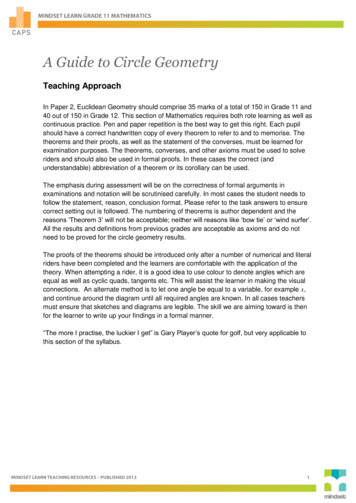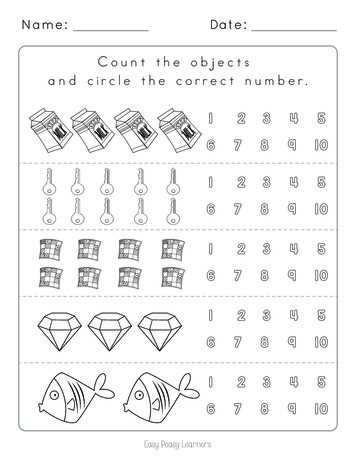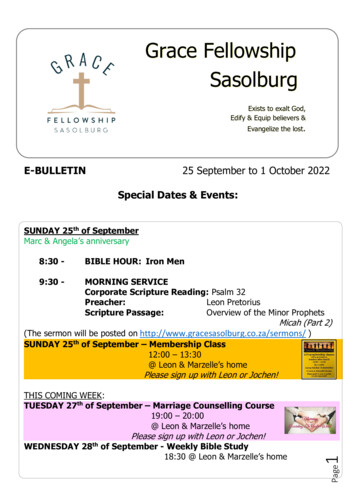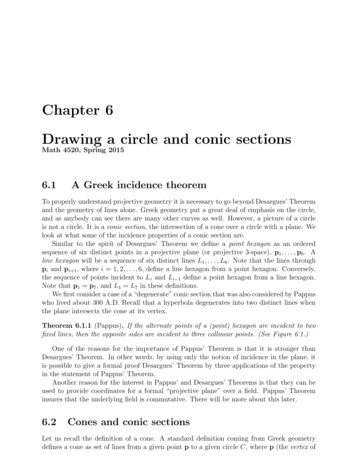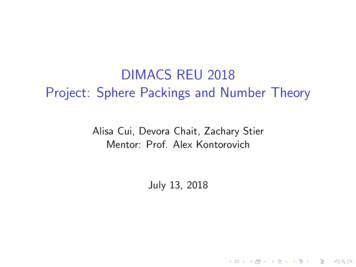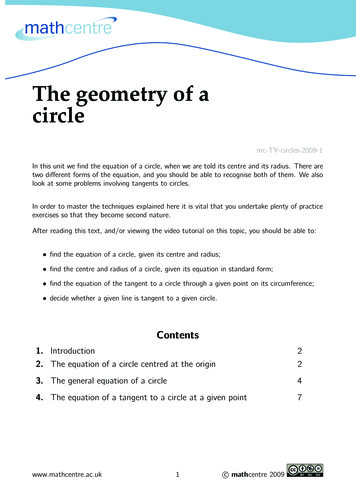
Transcription
The geometry of acirclemc-TY-circles-2009-1In this unit we find the equation of a circle, when we are told its centre and its radius. There aretwo different forms of the equation, and you should be able to recognise both of them. We alsolook at some problems involving tangents to circles.In order to master the techniques explained here it is vital that you undertake plenty of practiceexercises so that they become second nature.After reading this text, and/or viewing the video tutorial on this topic, you should be able to: find the equation of a circle, given its centre and radius; find the centre and radius of a circle, given its equation in standard form; find the equation of the tangent to a circle through a given point on its circumference; decide whether a given line is tangent to a given circle.Contents1. Introduction22. The equation of a circle centred at the origin23. The general equation of a circle44. The equation of a tangent to a circle at a given point7www.mathcentre.ac.uk1c mathcentre 2009
1. IntroductionThe circle is a familiar shape and it has a host of geometric properties that can be proved usingthe traditional Euclidean format. But it is sometimes useful to work in co-ordinates and thisrequires us to know the standard equation of a circle, how to interpret that equation and howto find the equation of a tangent to a circle. This video will explore these particular facets of acircle, using co-ordinate geometry.2. The equation of a circle centred at the originThe simplest case is that of a circle whose centre is at the origin. Let us take an example. Whatwill be the equation centred on the origin with radius 5 units?5P(x, y)5yxO 5N5 5If we take any point P (x, y) on the circle, then OP 5 is the radius of the circle. But OP is alsothe hypotenuse of the right-angled triangle OP N, formed when we drop a perpendicular from Pto the x-axis. Now in the right-angled triangle, ON x and NP y. Thus, using the theoremof Pythagoras,x2 y 2 52 25 .And this equation is true for any point on the circle. For instance, we could take a point Q(x1 , y1 )in a different quadrant.5Q(x1, y 1)y1 5N5x1O5 5Once again, we can drop a perpendicular from Q to the x-axis. And now we can use the rightangled triangle OQN to see that x21 y12 52 . So the co-ordinates (x1 , y1 ) of the point Q alsosatisfy the equation x2 y 2 25.www.mathcentre.ac.uk2c mathcentre 2009
We shall now take the radius of the circle to be r.rP(x, y)ryx rONr rIf we take any point P (x, y) on the circle, then OP r is the radius of the circle. But OP is alsothe hypotenuse of the right-angled triangle OP N, formed when we drop a perpendicular from Pto the x-axis. In the right-angled triangle, ON x and NP y. Thus, using the theorem ofPythagoras,x2 y 2 r 2 ,and this is the equation of a circle of radius r whose centre is the origin O(0, 0).Key PointThe equation of a circle of radius r and centre the origin isx2 y 2 r 2 .www.mathcentre.ac.uk3c mathcentre 2009
3. The general equation of a circleWhat is the equation of a circle of radius r, centred at the point C(a, b)?P(x, y)ry bC(a, b)Nx aOWe shall take a horizontal line through the centre C and drop a perpendicular from P to meetthis horizontal line at N. Then again we have a right-angled triangle CP N, where CP r isthe hypotenuse, and where we have CN x a and P N y b. Thus using Pythagoras againwe haveCN 2 P N 2 CP 2 ,so thatExpanding the brackets gives(x a)2 (y b)2 r 2 .x2 2ax a2 y 2 2by b2 r 2 ,and if we bring r 2 to the left-hand side and rearrange we getx2 2ax y 2 2by a2 b2 r 2 0 .It is a convention, at this point, to replace a by g and b by f . This givesx2 2gx y 2 2f y g 2 f 2 r 2 0 .Now look at the last three terms on the left-hand side, g 2 f 2 r 2 . These do not involve x or yat all, so together they just represent a single number that we can call c. Substituting this intothe equation finally gives usx2 2gx y 2 2f y c 0 .This is the general equation of a circle. We can recognise it, because it is quadratic in both xand y, and it has two additional properties. First, there is no term in xy. And secondly, thecoefficient of x2 is the same as the coefficient of y 2. (In fact, our equation has both coefficientsequal to 1, but you can always multiply an equation by a non-zero constant to obtain anothervalid equation, and so we must allow for this possibility.) The centre of the circle is then at(a, b) ( g, f ) and, since c g 2 f 2 r 2 , we haver2 g 2 f 2 c ,so that the radius of the circle is given byr www.mathcentre.ac.ukpg2 f 2 c .4c mathcentre 2009
Key PointThe general equation of a circle isx2 y 2 2gx 2f y c 0 ,pwhere the centre is given by ( g, f ) and the radius by r g 2 f 2 c. The equation canbe recognised because it is given by a quadratic expression in both x and y with no xy term,and where the coefficients of x2 and y 2 are equal.ExampleFind the centre and radius of the circlex2 y 2 6x 4y 12 0 .SolutionFirst, we can check that the expression on the left-hand side is quadratic, that there is no terminvolving xy, and that the coefficients of x2 and y 2 are equal. So this is the equation of a circle.If we compare this equation with the standard equationx2 y 2 2gx 2f y c 0 ,we see that g 3 and f 2, so that the centre is ( g, f ) (3, 2). We also see thatc 12, so we can find the radius by calculatingpg2 f 2 cr p ( 3)2 22 ( 12) 9 4 12 25 5.An alternative method is to attempt to reconstruct the equation of the circle in the form(x a)2 (y b)2 r 2by completing the square. We start by collecting together the terms in x, and the terms in y.So we rewrite our equationx2 y 2 6x 4y 12 0asx2 6x y 2 4y 12 0 .Now the terms in x must come from (x a)2 , a complete square, so we complete the square forthe x terms, and similarly for the y terms, to get(x 3)2 9 (y 2)2 4 12 0 .www.mathcentre.ac.uk5c mathcentre 2009
So we havewhich we rewrite as(x 3)2 (y 2)2 25 0 ,(x 3)2 (y 2)2 25 52 .We can now see that the centre of the circle is (3, 2) and the radius is 5.ExampleFind the centre and radius of the circle2x2 2y 2 8x 7y 0 .SolutionNotice that this is the equation of a circle, even though the coefficients of x2 and of y 2 are notequal to 1. But we can divide throughout by 2, and we getx2 y 2 4x 72 y 0 .If we compare this with the standard equationx2 y 2 2gx 2f y c 0we see that g 2 and f 74 , so the centre of the circle is ( g, f ) (2, 74 ). We also seethat c 0, so we find the radius by calculatingpg2 f 2 cr q 2( 2)2 47 q494 16 q113 16 1 4 113 .Alternatively, we could try completing the square to regain the form (x a)2 (y b)2 r 2 . Sowe start with our equation2x2 2y 2 8x 7y 0 ,and again we divide by 2 to getx2 y 2 4x 72 y 0 .Collecting the x terms together and the y terms together, we getx2 4x y 2 27 y 0 ,and then completing the square gives us(x 2)2 4 y so that(x 2)2 y 7 24 7 24 491611316 0.We can now see that the centre of the circle is (2, 74 ) and the radius iswww.mathcentre.ac.uk614 113.c mathcentre 2009
ExampleFind the centre and radius of the circlex2 y 2 8x 7 0 .SolutionNotice that, in this example, there is no y term. If we compare our equation with the standardequationx2 y 2 2gx 2f y c 0 ,we see that g 4 and f 0. So the centre of the circle is ( g, f ) ( 4, 0). We also seethat c 7, so we find the radius by calculatingpg2 f 2 cr 42 02 7 16 7 9 3.Exercises1. Find the equation of the circle with given centre and radius:(a) centre (3, 5), radius 3;(b) centre ( 2, 3), radius 1;(d) centre (2, 2), radius 5; (e) centre (0, 5) radius 4.2. Identify the centre and radius of the following circles:(a) x2 y 2 2x 4y 20 0,(c) x2 y 2 2x 3 0,(e) 3x2 3y 2 6x 9y 5 0.(c) centre ( 1, 3), radius 2;(b) x2 y 2 4x 6y 4 0,(d) x2 y 2 6x 7y 14 34 0,4. The equation of a tangent to a circle at a given pointWhat is the equation of the tangent to the circle x2 y 2 2x 4y 3 0 at the point (1, 4)on the circle?For a question like this, we should check first that the given point does indeed lie on the circle.If we substitute x 1 and y 4 into the equation, we obtain12 ( 4)2 2 1 4 ( 4) 3 1 16 2 ( 16) 3 0 ,and so the equation is satisfied. In fact we can see this from a diagram.tangent( 1, 2)(1, 4)www.mathcentre.ac.uk7c mathcentre 2009
We have also marked the centre of the circle on the diagram. To find the centre, we note thatg 1 and f 2, so that the centre is at ( 1, 2).A tangent is a straight line that just touches the circle. To find the equation of a straight line,we need to know either two points on it, or one point on it together with its gradient. In thisexample, we know one point on the line, the point (1, 4) where it is to touch the circle. Butwe do not know another point. Nor do we know the gradient. So what should we do?One fact we do know is that the tangent to a circle is perpendicular to the radius at the pointof contact. In this case, we know the point of contact (1, 4), and we also know the centre( 1, 2). We can therefore calculate the gradient of the radius from the centre to the point ofcontact, and hence the gradient of the tangent.Now the gradient m of a straight line joining the points (x1 , y1 ) and (x2 , y2 ) is given bym y2 y1.x2 x1So if we take (x1 , y1) (1, 4) and (x2 , y2 ) ( 1, 2), the gradient m1 of the radius ism1 ( 2) ( 4)2 1 .( 1) 1 2We now use the result that, if two lines with gradients m1 and m2 are perpendicular, thenm1 m2 1. Here, the gradient of the radius is m1 1, and so the gradient of the tangentmust be m2 1.Now we have enough information to find the equation of the tangent. We know that the equationof a straight line with a given gradient m 1 and containing a given point (x1 , y1) (1, 4) canbe found from the formulay y1 m(x x1 ) ,and so the equation of the tangent is given byy ( 4) 1 (x 1)y 4 x 1y x 5.Key PointTo find the equation of the tangent to a circle through a given point of contact, you should firstfind the centre of the circle and then calculate the gradient m1 of the line joining the centre tothe point of contact.Having done this, you should find the gradient m2 of the tangent, using the formula m1 m2 1.As you now know the gradient and one point on the tangent, you can find the equation of thetangent.www.mathcentre.ac.uk8c mathcentre 2009
ExampleFind the equation of the tangent at the point (0, 2) to the circle x2 y 2 4x 2y 8 0.SolutionWe start by finding the centre of the circle. From the equation, we see that g 2 and f 1,so the centre of the circle is at (2, 1).(0, 2)(2, 1)Let us take (x1 , y1) (0, 2) and (x2 , y2 ) (2, 1). Then the gradient m1 of the radius joiningthese two points is( 1) 23y2 y1 .m1 x2 x12 02If the tangent has gradient m2 then we must have m1 m2 1 as the tangent and the radiusare perpendicular, and so m2 32 .Now we can find the equation of the tangent. We know the gradient m2 32 , and we know apoint (x1 , y1 ) (0, 2). So the tangent is given byy y1 m2 (x x1 )y 2 32 (x 0)y 23 x 2 .Note that the y-intercept of this line is 2, as we would expect from the fact that it passes throughthe given point (0, 2).Exercises3. Find the equation of the tangent to each circle at the point irclex2 y 2 2x 4y 20 0, point (4, 2);x2 y 2 4x 2y 20 0, point (1, 3);x2 y 2 6x 4y 87 0, point ( 3, 10);x2 y 2 18x 88 0, point (3, 5);x2 y 2 6y 160 0, point (12, 8).www.mathcentre.ac.uk9c mathcentre 2009
4. Find the points of intersection of the line y 2x 1 and the circle x2 y 2 2y 4 0.Show that the line y 2x 1 is a diameter of the circle. Find the equation of the tangent tothe circle at one of the points of intersection.5. Find the points of intersection of the line y x 3 and the circle x2 y 2 2x 2y 1 0.What are the tangents at the points of intersection? Where do they intersect?6. Find the points where the circle x2 y 2 10x 10y 40 0 and the line y 2x 10intersect. Find the equation of the tangent to the circle at each of the points of intersection.Find the point of intersection of these two tangents.7. Show that the equation of the tangent at the point (x1 , y1 ) on the circlex2 y 2 2gx 2f y c 0is given byxx1 yy1 g(x x1 ) f (y y1 ) c 0 .Answers1.(a) x2 y 2 6x 10y 25 0 (b)(c) x2 y 2 2x 6y 6 0(d)22(e) x y 10y 9 02.(a)centre (1, 2), radius 5(d) centre ( 3, 72 ), radius 6(b)(e)x2 y 2 4x 6y 12 0x2 y 2 4x 4y 17 0centre (2, 3), radius 3qcentre (1, 23 ), radius 19123.(a) 4y 3x 20 (b) 4y 3x 15(c)(d) 5y 12x 61 (e) 5y 12x 184(c) centre ( 1, 0), radius 24y 3x 49 04. The points of intersection are (1, 3) and ( 1, 1). The mid-point of these is (0, 1) which isthe centre of the circle, and hence y 2x 1 is a diameter. The tangents are 2y x 7 and2y x 3 respectively.5. The points of intersection are (1, 2) and (2, 1). The tangents are y 2 and x 2respectively. They intersect at the point (2, 2).6. The points of intersection are (4, 2) and (2, 6). The tangents are 3y x 10 and y 3xrespectively. They intersect at the point (1, 3).www.mathcentre.ac.uk10c mathcentre 2009
find the equation of the tangent to a circle through a given point on its circumference; decide whether a given line is tangent to a given circle. Contents 1. Introduction 2 2. The equation of a circle centred at the origin 2 3. The general equation of a circle 4 4. The equation of a tangent to a circle at a given point 7 www.mathcentre .


